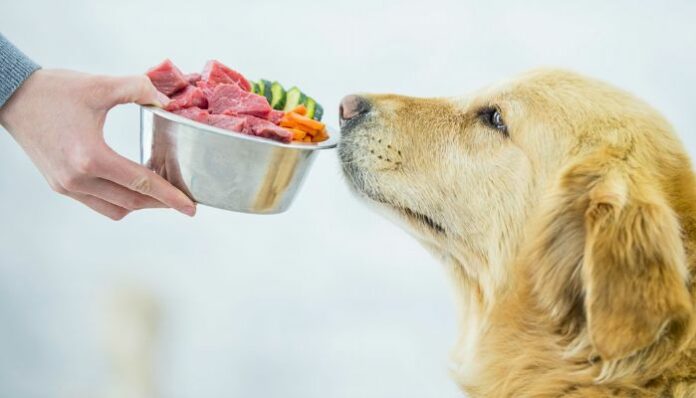Introduction
In this post, we will explore the best dog food for weight gain, focusing on high-quality, calorie-dense formulas designed to help your pup pack on the pounds safely and effectively. By the end, you’ll have valuable insights and recommendations to ensure your dog thrives with a well-balanced diet tailored for healthy weight gain.
Understanding Weight Gain for Dogs
When a dog is underweight, it can lead to several health issues. Weight loss may result from poor nutrition, illness, or high activity levels. As a responsible pet owner, addressing your dog’s weight is crucial for their overall health. A lack of sufficient weight can compromise their energy levels and weaken their immune system.
To help your furry friend gain weight, choosing the right dog food is essential. The best dog food for weight gain provides extra calories, protein, and essential nutrients. Additionally, it should be delicious to encourage your dog to eat. Keep an eye on your dog’s weight and change their diet as necessary.
How to Get Dog Food Cheap
Feeding your dog healthy food doesn’t have to break the bank. Here are several strategies to consider when looking for affordable options:
Look for Sales and Discounts: Keep an eye on local pet stores for weekly promotions or discounts. Many stores offer sales on specific brands.
Online Retailers: Websites like Chewy or Amazon often provide competitive pricing and special discounts. Signing up for newsletters can also lead to exclusive deals.
Purchase in larger amounts: Buying in bulk can help you save money over time. Just make sure to keep the food fresh.
Subscription Services: Consider using pet food subscription services. These often offer lower prices and deliver the food directly to your door.
Price Comparison: Use price comparison websites or apps to find the best deals on dog food. This guarantees that you’re getting the best price available.
Store Brands: Don’t overlook store-brand pet foods, which can be just as nutritious as name-brand options but at a lower cost.
How Much to Feed an Underweight Dog?
Determining the right amount of food for your underweight dog is essential. Here are some important things to consider:
Consult Your Veterinarian: Before making any changes, consult your vet to establish a feeding plan tailored to your dog’s specific needs. They can assist in identifying any hidden health problems.
Gradual Increase: Increase the serving size gradually. Start by adding a small amount to their current diet, then adjust based on their response.
Monitor Weight: Weigh your dog regularly. Keep a journal of their weight changes to track progress accurately.
Adjust Based on Progress: If your dog isn’t gaining weight, increase the food amount slightly. Aim for a weight gain of about 1 to 2% per week.
Consider Feeding Frequency: You may also want to increase feeding frequency. Instead of two meals a day, try three or four smaller meals.
Observe Behavior: Monitor your dog’s appetite and energy levels. If they seem lethargic or disinterested in food, consult your vet.
Dry Dog Food for Weight Gain
Many dry dog foods are specifically formulated for weight gain. Here are some options to consider:
High-Calorie Options: Look for foods that are higher in calories than standard dog food. High-quality brands typically list meat as the first ingredient.
Healthy Fats: Ensure the food contains healthy fats, which are crucial for weight gain and overall health. Omega-3 and omega-6 fatty acids are great options.
Nutrient-Rich Ingredients: Ingredients such as chicken, beef, and fish are ideal sources of protein. Look for dog foods that include these meats along with whole grains.
Digestibility: Choose foods that are easily digestible. This will help ensure that your dog absorbs the nutrients efficiently.
High Calorie Dog Food
High-calorie dog food can be a great choice for weight gain. Here’s what to know:
Caloric Density: High-calorie dog foods contain more calories per cup than regular dog food. Look for products that offer at least 30% protein and 20% fat.
Benefits: High-calorie foods help dogs gain weight safely while providing balanced nutrition. They can also improve your dog’s overall energy levels.
Transition Gradually: If switching to high-calorie food, transition gradually. Mix the new food with the old food over a week to avoid digestive issues.
Read Labels: Always read labels to understand the nutritional content. This helps ensure you’re making informed choices for your dog’s diet.
Homemade Food for Dogs to Gain Weight
Homemade dog food can be an excellent option for weight gain. Here’s how to make it:
Balanced Ingredients: Focus on creating meals that are high in calories and nutritious. Use ingredients like brown rice, sweet potatoes, and lean meats.
Healthy Fats: Add healthy fats like olive oil, fish oil, or peanut butter to increase calorie content. These fats are beneficial for weight gain.
Recipe Ideas: Consider recipes that combine protein, carbs, and fats. For example, mix ground turkey with brown rice and peas for a nutritious meal.
Consult Your Vet: Always consult your vet before making significant dietary changes. They can help ensure your homemade meals meet your dog’s nutritional needs.
Monitor Your Dog: Keep an eye on your dog’s weight and energy levels after switching to homemade food. Adjust recipes as needed based on their progress.
Conclusion
Finding the best dog food for weight gain is vital for your dog’s health. Whether you choose high-quality commercial food or homemade options, focus on calorie density and balanced nutrition. Regular monitoring and adjustments will help your furry friend reach a healthy weight. By following these tips, you can ensure your dog gains weight safely and thrives!

